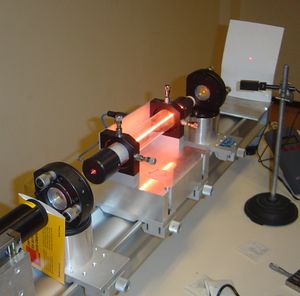Difference between revisions of "Helium"
| Line 120: | Line 120: | ||
*[http://www.tunl.duke.edu/nucldata/HTML/A=3/03He_1987.shtml Nuclear data] | *[http://www.tunl.duke.edu/nucldata/HTML/A=3/03He_1987.shtml Nuclear data] | ||
| − | + | Yeah that's what I'm tkailng about baby--nice work! | |
| − | |||
| − | |||
| − | |||
| − | |||
| − | |||
| − | |||
| − | |||
Revision as of 01:04, 10 December 2011
| Helium | |
|---|---|
| He | |
| In situ availability: | trace |
| Necessity: | |
| Atomic number: | 2 |
| Atomic mass: | 4.002602 |
| group: | 18 |
| period: | 1 |
| normal phase: | Gas |
| series: | Noble gases |
| density: | 0.1786 g/L |
| melting point: | 0.95K, -272.2°C, -458.0°F |
| boiling point: | 4.22K, -268.93°C, -452.07°F |
| N/A ← N/A → N/A | |
| H ← He → N/A | |
| F ← Ne → N/A | |
| Atomic radius (pm): | 31 pm |
| Bohr radius (pm): | |
| Covalent radius (pm): | 32 |
| Van der Waals radius (pm): | 140 |
| ionic radius (pm): | - |
| 1st ion potential (eV): | 24.59 |
| Electron Configuration | |
| 1s2 | |
| Electrons Per Shell | |
| 2 | |
| Electronegativity: | |
| Electron Affinity: | Unstable anion |
| Oxidation states: | - |
| Magnetism: | |
| Crystal structure: | Hexagonal or body centered cubic |
Helium is a component of the solar wind, and hence is one of the volatiles found (in parts per million level) in Lunar regolith. It is a Noble gas in group 18 and is the second element in the Periodic Table of the Elements. This element has two stable isotopes: 3 and 4.
The most common isotope, Helium-4, has a nucleus of two protons and two neutrons, and two electrons. The less common isotope Helium-3 has two protons and one neutron.
Contents
3He
Helium 3 is a rare isotope of the element Helium, consisting of a nucleus with two protons and one neutron. The approved abbreviation (for physics use) for Helium-3 is 3He, however, the abbreviation He3 is also seen. Since most of the Earth's helium is produced by alpha-decay of Uranium isotopes, resulting in 4He (the most common isotope of Helium), 3He is rare on Earth. It is comparatively more abundant in non-terrestrial sources, although even in non-terrestrial sources, only a small fraction of helium atoms are Helium 3. The Moon is a source of 3He, which is implanted into the lunar regolith by the solar wind. Helium is present in the soil in quantities of ten to a hundred (weight) parts per million, and 0.003 to 1 percent of this amount (depending on soil) is 3He.
Helium 3 as a Fusion Reaction Fuel
It has been proposed that 3He might be a possible fuel for a Nuclear Fusion reactor to produce energy using the thermo-nuclear reaction (Deuterium-Helium-3):
2H + 3He --> 4He + 1H+
This reaction has the advantage over the more-commonly proposed Deuterium-Tritium fusion reaction
(2H + 3H) --> 4He + Neutron
that the reaction produces only charged particles (an alpha particle and a proton), with no production of neutrons. However, the corresponding difficulty is that the 2H -3He reaction has an ignition barrier that is twice as high as the barrier to igniting 2H-3H fusion, because of the fact that the Helium nucleus has twice the charge of a Tritium nucleus. Gerald Kulcinski's group at the Fusion Technology Institute of the University of Wisconsin-Madison has operated an experimental 2H-3He fusion reactor for an extended period, on a non-governmental research budget [1], however the reactor has not achieved energy balance or "break even". So far, 2H-3He fusion has not yet demonstrated net energy production ("break even"). The development of commercial 2H-3He reactors is dependent upon demonstrating "break even."
Helium 3 Fusion and a Lunar Settlement Window
Mining Helium 3 from the lunar regolith for generation of power on Earth is a very attractive economic foundation for a lunar settlement economy. A number of powerful historic forces are pushing the human race in this direction, but the hurdles that must be overcome are daunting.
Human civilization needs a source of electrical power to maintain itself. Currently we are running on fossil fuels that are a limited resource and dump of huge amounts of greenhouse gases into Earth's atmosphere. Even given the immense effort that it will take to develop fusion as a power source, fusion is currently one of our best possibilities for addressing the global warming problem.
Current fission reactors will not meet 21st century needs. They are limited by the possibility of nuclear proliferation, safe handling of the radioactive wastes, the amount of high grade ore available, and problems with the decommissioning of radioactive power plants at end-of-life.
There are several possible fusion fuels (Deuterium, Tritium, Helium 3, and Boron 11) that could be used. Only one, Helium 3, comes from the Moon.
Each fuel has different prospect for use. The relative economic values can be judged by: (1) ease of ignition, (2) possibility of power generation, and (3) safety of wastes produced. Three of the top five possibilities are rated below:
| Fuel | Lawson Criterion | Relative Power Density | Neutronicity |
| Deuterium-Tritium | 1 | 1 | 0.80 |
| Deuterium-Helium 3 | 16 | 80 | 0.05 |
| Proton-Boron 11 | 500 | 2500 | 0.001 |
The Lawson Criterion is a index of how difficult the reaction is to initiate with respect to the Deuterium-Tritium reaction. The Relative Power Density gives an idea of how much power might be harnessed commercially. The Neutronicity shows how much of the energy produced comes off in the form of fast neutrons which produce most of the radioactive wastes.
This basic comparison suggests a possible economic window of opportunity for lunar Helium 3 mining. The easiest fusion fuel, Deuterium-Tritium, comes from the seas of Earth, but the Tritium must be produced in conventional fission reactors and the fusion facility would slowly become radioactive and turn into a huge pile of radioactive waste after about 40 years of operation.
The Helium 3 reaction is more difficult to initiate, but produces more energy with each reaction and produces negotiable radioactive wastes. Its problem is that the bulk of Helium 3 will have to be mined on the Moon at great cost.
As fusion technology progresses, we will likely someday be able to fuse Boron 11. This is far more difficult to do, but yields far more energy while generating truly negotiable radioactive wastes. All this fuel's constituent parts are available at low cost on Earth.
This suggests a window of opportunity for a lunar Helium 3 mining settlement. The following historic events need to take place to open this window: (1) it is determined that dumping carbon dioxide into Earth atmosphere must be stopped no matter what the cost, (2) wind and solar are not up to the job alone, (3) Deuterium-Tritium power production is accomplished, (4) Deuterium-Helium 3 power production is demonstrated, and (5) we build a lunar mining settlement. There is nothing unreasonable in this list, although there is also nothing certain.
This window would start to close when commercial Boron 11 fusion is demonstrated. The established lunar settlement will then have to find other means of economic support.
Geez, that's unbelivealbe. Kudos and such.
Applications
- Medical Lung Imaging
- According to Wikipedia:
- http://en.wikipedia.org/wiki/Helium_3
- Details on this experimental application of He3: http://cerncourier.com/main/article/41/8/14
| This section of the article is incomplete or needs more detail. You can help Lunarpedia by expanding or correcting it. |
Related Articles
External Links
Yeah that's what I'm tkailng about baby--nice work!







